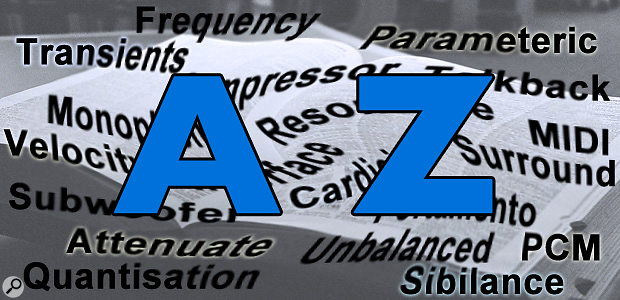You are here
Glossary
The time delay experienced between a sound or control signal being generated and it being auditioned or taking effect, measured in seconds. (cf. Delay) Each 1ms of latency = approximately being 1 foot away from your speakers, which means with headphones/IEMs (In-ear Monitors) you might get away with slightly higher audio interface latency than with speakers/wedges. If your computer can handle it, switching to higher sample rates like 96kHz when recording can reduce latency.
The distance along the length of a cable over which the twisted core wires complete one complete turn. Shorter lay lengths provide better rejection of electromagnetic interference, but make the cable less flexible and more expensive.
Liquid Crystal Display.
Large Diaphragm Capacitor microphone — a microphone with a diaphragm diameter of more than about 20mm
Light Emitting Diode. A form of solid state lamp.
Low Frequency Oscillator, often found in synths or effects using modulation.
see ADAT Lightpipe.
An automatic gain-control device used to restrict the dynamic range of an audio signal. A Limiter is a form of compressor optimised to control brief, high level transients with a ratio greater than 10:1.
A nominal signal level which is around -10dBV for semi-pro equipment and +4dBu for professional equipment.
A device where the output is a direct multiple of the input with no unwanted distortions.
A type of filter design where the phase response is a linear function of frequency. In other words, all frequencies are delayed in their passage through the filter by exactly the same amount.
see LUFS.
An electrical load is a circuit that draws power from another circuit or power supply. The term also describes reading data into a computer system.
A function to allow the keyboard and sound generating section of a keyboard synthesizer to be used independently of each other.
A type of electronic circuitry used for processing binary signals comprising two discrete voltage levels.
A number of separate cables bound together for neatness and convenience.
The practice of trying to make each new commercial music release sound subjectively louder than any previous release, on the misguided notion that louder is more exciting and results in more sales. A relationship between the average loudness of 45rpm singles and sales was noticed in America from jukebox plays, and that led to the first loudness war. However, the advent of the CD really ramped up the situation, with music becoming ever-more dynamically compressed to squeeze the average level higher and higher towards the 0dBFS peak level. This desctructive trend is, thankfully, now being slowly reversed with the ubiquity of loudness normalisation adopted by most online audio streaming services and broadcasters.
The practice of matching the perceived loudness of different material to a given target loudness value. To accommodate varying peak levels, the medium requires an approporiate headroom margin. Loudness-normalisation is now the default form for HDTV broadcasts, as well as most audio streaming services, although the target loudness level currently varies between different platforms. Loudness-normalisation is measured using the LUFS or LKFS scale. (See LUFS, Peak-Normalisation, Mastering, Loudness Wars).
A filter which passes frequencies below its cut-off frequency, but attenuates higher frequencies. Also known as a 'high-cut' filter.
The lower portion of the audible frequency spectrum, typically denoting frequencies below about 1kHz
Least Significant Bit. In a binary number the bit that carries the smallest multiplier value (units) is deemed the least significant bit, and is typically the right-most digit in a binary number. The three-bit binary equivalent of the decimal number 1 is 001, and the bit showing 1 is the LSB.
LU — Loudness Units. A measure of loudness normalisation relative to the target loudness. If the integrated loudness of a track measured -21LUFS, but the target loudness was -23LUFS, the meter would show a +2LU discrepancy.
The standard measurement of loudness, as used on Loudness Meters corresponding to the ITU-TR BS1770 specification. the acronym stands for 'Loudness Units (relative to) Full Scale. Earlier versions of the specification used LKFS instead, and this label remains in use in America. The K refers to the 'K-Weighting' filter used in the signal measurement process. (See this article on the loudness metering concept.)

